This site is made possible by its sponsors.
Please visit them!
 seal - A die or
signet having a design or emblem which is in relief,
used to stamp an impression
on a temporarily soft substance such as hot wax or lead,
or the impression made in this way. Seals have been affixed to
documents to prove their authenticity
or to secure them from tampering.
seal - A die or
signet having a design or emblem which is in relief,
used to stamp an impression
on a temporarily soft substance such as hot wax or lead,
or the impression made in this way. Seals have been affixed to
documents to prove their authenticity
or to secure them from tampering.
Examples:

Mesopotamia, Cylinder seal and modern impression: hunting
scene, 2250-2150 BCE,
Late Akkadian period, chert, height
1.1 inches (2.8 cm), Metropolitan Museum of Art, NY. See
cylinder and Mesopotamian art.
Syria, Cylinder seal and modern impression: worshiper approaching bearded god, 1820-1730 BCE, Classic Syrian I style, hematite, height 0.8 inches (2 cm), Metropolitan Museum of Art, NY.

Minos, c. 1450-1400 BCE,
Late Minoan II, Lentoid seal with a griffin, agate, height 1 1/16 inches (2.7 cm),
width 1 1/16 inches (2.7 cm),
diameter 1/2 inches (1.2
cm), Metropolitan Museum of Art, NY.
Mesopotamia, Cylinder seal and modern impression: Ishtar image and a worshipper below a canopy flanked by winged genies, 8th-7th century BCE, Neo-Assyrian modeled style, chalcedony, height 1 1/4 inches (3.1 cm), Metropolitan Museum of Art, NY.
![]()


![]()
American, [two versions of the] Seal of the United States Department of State, which is based upon the Great Seal of the United States of America. See the United States Department of State.

American, Seal of the Paradise Valley
Unified School District, Phoenix, Arizona, c. 2000. This
may well be the finest school district in the known universe.
(The author of these lines may be somewhat biased. He is an educator
of wonderful students in the Paradise Valley Unified School District.)
See pinnacle.
Also see Art & Craft Materials Institute (ACMI), glyptic, hallmark, heraldry, intaglio, logo, sign, signature, and stamp.
seasoning - The long process of drying out most of the natural moisture in wood to make it stable and workable for carving or construction.
Also see heartwood or sapwood.
secession or Sezession - In art, "secession" ("Sezession" in German) is the name adopted by each of several associations of avant-garde artists, especially those in Munich, Berlin, and Vienna, who broke away (seceded) from the established, more conservative, academic societies and their exhibitions. The artists of Munich formed a secession in 1892 that spread to other German cities. Its leading members were Max Liebermann (German, 1847-1935), Wilhelm Trübner (German, 1851-1917), Lovis Corinth (German, 1858-1925), and Franz von Stuck (German, 1863-1928). The Berlin Secession, led by Liebermann, split away from the Verein Berliner Künstler in 1899, and held its first exhibition in its own building in 1899. In 1910, the Berlin Secession rejected a number of younger painters, including several artists of Die Brücke — Max Pechstein (German, 1881-1955) principal among them — who organized the New Secession group (Neue Sezession). The Vienna Secession was founded in 1897 by nineteen leading Austrian artists. At their head was Gustav Klimt (Austrian, 1862-1918), whose decorative, exotic paintings exemplify Secessionstil, the Viennese version of Art Nouveau. The Photo-Secession group was an American association of modern photographers who rejected pictorial photography. It was formed in 1902 in New York City by Alfred Stieglitz (American, 1864-1946) and Edward Steichen (American, 1879-1973).
Examples:

Max Liebermann (German, 1847-1935), The Parrot Man (Der Papageienmann),
1902, oil on canvas,
Folkwang Museum, Essen, Germany.
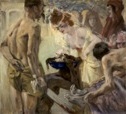
Lovis Corinth (German, 1858-1925), Salomé, 1899, oil
on canvas, 76.2 cm. x 83.5
cm, Busch-Reisinger Museum, Harvard U, Cambridge, MA.

Lovis Corinth, Landscape, 1904, charcoal
with orange pastel
and white gouache,
sheet: 46.4cm x 61.4cm, Cleveland Museum of Art, OH.

Lovis Corinth, Fan Design, recto,
probably 1906, graphite on
green paper, lunette: 24.1
x 46.8 cm (9 1/2 x 18 7/16 inches), National Gallery, Washington,
DC. See fan.
Lovis Corinth, The Temptation of St. Anthony after Gustave Flaubert, 1908, oil on canvas, 135.3 x 200.3 cm, Tate Gallery, London.

Gustav Klimt (Austrian, 1862-1918), Serena Lederer (died 1943), 1899, oil on canvas,
75 1/8 x 33 5/8 inches (190.8 x 85.4 cm), Metropolitan Museum
of Art, NY. See Art
Nouveau, Austrian art, and
portrait.

Gustav Klimt, Portrait of Hermine Gallia, 1904, oil on canvas,
170.5 x 96.5 cm, Tate Gallery, London.
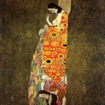
Gustav Klimt (Austrian, 1862-1918), Hope, II, 1907-08, oil,
gold, and platinum on canvas,
43 1/2 x 43 1/2 inches, (110.5 x 110.5 cm), Museum of Modern
Art, NY. See Austrian art.

Gustav Klimt, Mäda Primavesi (born l903), 1912,
oil on canvas,
59 x 43 1/2 inches (149.9 x 110.5 cm), Metropolitan Museum of
Art, NY.
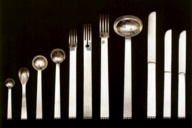
Josef Hoffmann (Austrian, 1870-1956) for
Wiener Werkstätte, part of the Flat Model cutlery set, silver, c.1903-1904. See model.
Josef Hoffmann for Wiener Werkstätte, Fruit Basket, 1904, silver, Victoria and Albert Museum, London. See Art Nouveau and basket.

Josef Hoffmann (Austrian, 1870-1956), designer, at the studio of Wiener Werkstätte, for J. & J. Kohn, Austrian manufacturer, Sitzmaschine Chair with Adjustable Back, c. 1905, bent beechwood and sycamore panels, 43 1/2 x 28 1/4 x 32 inches (110.5 x 71.8 x 81.3 cm), Museum of Modern Art, NY. "Sitzmashine" is a word Hoffmann coined in German, literally meaning "machine for sitting," an apparent bow to the mechanical aspects of the modernism. The angle of the back of the chair can be adjusted by moving a supporting bar to any of several positions. This capability was first given to chairs often referred to as Morris chairs, in recognition of the chair produced by the firm headed by William Morris (English, 1834-1896), leader of England's Arts and Crafts Movement. See wood.
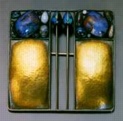
Josef Hoffmann for
Wiener Werkstätte, Square Brooch, silver lattice, repoussé gold, and opal, c. 1905. See jewelry and opalescence.

Max Pechstein (German, 1881-1955), Early Morning, 1914, oil
on canvas, 32 1/4 x 39 3/4
inches, Portland Art Museum, ME. See Expressionism.


secondary colors - The colors
obtained by mixing equal amounts of two primary
colors. The secondary colors in subtractive color mixing (when
the sources of color are pigments
or reflective surfaces
instead of light itself) are orange,
green, and violet, as in the diagram and the picture to the right.
(In this diagram, where do the primary colors — red, yellow,
and blue — belong?)
In additive color mixing (when the sources of color are light sources instead of reflective surfaces), the secondary colors are magenta, yellow, and cyan. Also see color wheel, and see intermediate colors, which are sometimes called tertiary colors.
Also see CMYK (cyan magenta yellow black) and RGB (red green blue).
section - A representation of an object as it would appear if cut by an intersecting plane, so that the internal structure is displayed. Also called a cross-section (which you should see for images of examples).
Section of Fine Arts (SFA) - See Section of Painting and Sculpture (SPS).
The Section of Painting and Sculpture (SPS) - An agency of the U.S. government's Treasury Department during the Great Depression of the 1930s and 1940s. It was a part of the federal bureaucracy which administered New Deal art programs. It was later known as the Section of Fine Arts (SFA).
secular humanism - Also called secularism, this philosophy advocates human rather than religious values. A powerful intellectual force behind the Renaissance (as well as since), especially stimulating studies of the sciences, when for centuries scholarship had been focused almost exclusively upon issues of faith.
Also see humanism.
secularism - See secular humanism.
sedimentary rock - Rock formed by the deposit of eroded igneous rock, often in strata or beds. Examples include limestone and sandstone.
Segantini stitch - In painting, a divisionist brushstroke technique characterized by short, slanting, hatched brushstrokes. It was named after Giovanni Segantini (Italian, 1858-1899), the painter who derived it from the work of van Gogh (Dutch, 1853-1890) and Seurat (French, 1859-1891). Marsden Hartley (American, 1877-1943) is one of many painters who have employed the Segantini stitch.
Examples:

Giovanni Segantini, Noontime in the Alps (Mezzogiorno sulle Alpi),
1891, oil on canvas,
77.5 x 71.5 cm, Otto Fischbacher Giovanni Segantini Stiftung,
St. Gallen.
Giovanni Segantini, L'ora Mesta, 1892, oil on canvas, 45.5 x 83 cm, private collection.
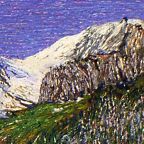
Giovanni Segantini, Springtime in the Alps, 1897, oil
on canvas, 119 x 230 cm. Zooming in on this image affords
a fair appreciation of Segantini's hatched
brushstroke technique.
That
technique, as revealed in this detail
of sky and mountains in Springtime in the Alps, makes
the painting appear as if it were embroidered.

Giovanni Segantini, Love at the Fountain of Life (L'amore alla fonte
della vita), oil on
canvas, 72 x 100 cm, Civica
Galleria d'Arte Moderna, Milano.
See Art Nouveau, Post-Impressionism and Neo-Impressionism.
seicento - Italian, literally "600," it refers to the 1600s — the seventeenth century. It is especially used to refer to Italian art of that century, the time of the Baroque period in art, the Reformation and Counter-Reformation in religion and politics.
(pr. say-CHAYN-toh)
Examples of Italian seicento paintings:

Caravaggio (Michelangelo Merisi) (Italian, Lombard, 1571/73-1610), The Musicians, c. 1595, oil on canvas, 36 1/4 x 46 5/8 inches (92.1 x 118.4 cm), Metropolitan Museum of Art, NY. (On the Met's page, you can enlarge any detail.) See Baroque.
Caravaggio (Michelangelo Merisi), The Crucifixion of St. Andrew, 1607, oil on canvas, 202.5 x 152.7 cm, Cleveland Museum of Art.
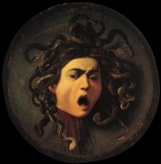
Caravaggio (Michelangelo Merisi), Medusa, oil on a circular convex leather shield, diameter 55.5 cm, Uffizi Gallery, Florence. See Caravaggisti, mythology, and snake.
Guido Reni (Italian, 1575-1642), Hippomenes and Atalanta, oil on canvas (206 x 297 cm), Prado Museum, Madrid.
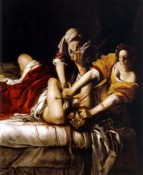
Artemisia Gentileschi (Italian, 1593-1651/53), Judith Beheading Holofernes, 1620, oil on canvas, 78 3/8 x 64 inches (199 x 162.5 cm),
Uffizi, Florence. See feminism and feminist art.
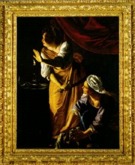
Artemisia Gentileschi (Italian, 1593-1651/53), Judith and Her Maidservant with the Head of Holofernes, c. 1625, oil on canvas, 1.8 x 1.4 m (72 1/2 x 55 3/4 inches, Detroit Institute of Art, MI. See frame.
![]()
Gianlorenzo Bernini (Italian [Roman], 1598-1680), Boy with a Dragon, Rome, 1614-1620, marble, 22 x 20 x 16 inches (55.7 x 52 x 41.5 cm), J. Paul Getty Museum, Malibu, CA.
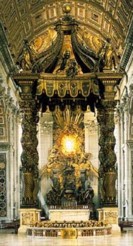
Gianlorenzo Bernini, Baldacchino, 1624-33, Saint Peter's Basilica, Vatican, Rome. Beyond the baldacchino, is The Throne of Saint Peter, 1657-66, marble, white and gilt stucco, and stained glass, overall height about 100 feet, a huge sculptural composition behind the altar, in the apse of the basilica. The focal point of the Throne is the stained glass Dove of the Holy Spirit, c. 1660.
| Italian term | Numerically | English term |
|---|---|---|
| duecento | 1200s |
thirteenth century |
| trecento | 1300s |
fourteenth century |
| quattrocento | 1400s |
fifteenth century |
| cinquecento | 1500s |
sixteenth century |
| seicento | 1600s |
seventeenth century |
| settecento | 1700s |
eighteenth century |
| ottocento | 1800s |
nineteenth century |
| novecento | 1900s |
twentieth century |
| diecicento | 2000s |
twenty-first century |
semi-gloss - A surface finish that is between glossy and matt. Oil, acrylic, and encaustic paints, among other media are generally available in semi-gloss.
Also see enamel, polyurethane, shellac, and varnish.
semi-matt - A finish in gilding which is often achieved by giving a polish to the bole or other surface that is to receive the gold leaf. Semi-matt is known in Italian as satinato.
seminal - Creative. Having the power to originate. Highly influential in an original way; constituting or providing a basis for further development.
Quote:
semiotic or semiotics - Of or relating to semantics; a linguistic, or literary study of the meaning of forms — signs and symbols and how they are used to represent. It includes studies of iconography, iconology, and typology. Semiotics is studied by a semiotician (the term favored in the USA) or semiologist (Europe). It is strongly associated with postmodernism.
Semiotics originated largely with Ferdinand de Saussure (Swiss linguist, 1857-1913) and Charles Sanders Peirce (American pragmatist, 1839-1914; pr. purse). Independently, they worked to better understand how certain structures were able to produce meaning rather than work on the traditional matter of meaning itself.
Saussure's work on semiotics is better known, and he argued that there was no inherent or necessary relationship between that which carries the meaning (the signifier, usually a word or symbol) and the actual meaning which is carried (the signified). For example, the word "dog" is not actually a dog — the meaning of dog could be carried by any random string of letters. It just so happens that, in English, that meaning is carried by the letters d-o-g.
Peirce's ideas about semiotics distinguished between three types of signs: icon, index and symbol. Whether a sign belongs in one category or another is dependent upon the nature of its relationship between the sign itself (which he called the referent) and the actual meaning. An icon is a meaning which is based upon similarity or appearance (for example, similarity in shape).
According to Pierce, icons are "the only means of directly communicating an idea." An index is a meaning based upon some cause and effect relationship (for example, a thermometer carries certain meaning because of variation in temperature): "Because the indexical sign is understood to be connected to the real object, it is capable of making that object conceptually present."
A symbol carries meaning in a purely arbitrary way, although there are often natural and cultural influences on their making of meaning. Saussure's system is appropriate to language and texts, for the most part, but Pierce's has a wider application, including not just language but imagery as well.
An important concept in semiotics is that signs and meaning are unlimited. Called "unlimited semiosis," this principle makes it clear that one sign or set of signs can take the place of some other sign or set of signs in a theoretically infinite process. If this were not possible, then artists would eventually run out of signs with which to carry meaning, and that would be the end of art itself.
Quote:
Other resources about semiotics:
Also see analogy, appropriation, commodification, knowledge, likeness, metaphor, simile, simulacrum, simulation, and theory.
Sengoku Jidai - A period in Japanese art history from 1490 - 1573. It was preceded by the Muromachi / Ashikaga period (1392-1573) and followed by the Momoyama period (1573-1615).
Examples of Sengoku Jidai art:
Attributed to Shuban (Japanese, active early-mid 15th century), Colors of Streams, Hues of Mountains, hanging scroll, ink and color on paper.
Sesshu Toyo (Japanese, 1420-1506), Winter Landscape, hanging scroll, ink on paper.
 sense or senses - The faculties through
which the body perceives, receives and feels stimuli
from outside, as the faculties of sight,
hearing, smell, touch, taste, and balance.
Or, a feeling, sensation, or perception.
A meaning conveyed; signification.
It may also refer to sensations understood, estimated, intuited,
or even vaguely felt. It is sometimes associated with sensuality,
because the senses are the means of providing physical gratification
and pleasure.
sense or senses - The faculties through
which the body perceives, receives and feels stimuli
from outside, as the faculties of sight,
hearing, smell, touch, taste, and balance.
Or, a feeling, sensation, or perception.
A meaning conveyed; signification.
It may also refer to sensations understood, estimated, intuited,
or even vaguely felt. It is sometimes associated with sensuality,
because the senses are the means of providing physical gratification
and pleasure.
Also see allegory, haptic, memory, mind, motivation, multiple intelligence theory, music, percept, sensitivity, sensorium, synesthesia, and tactile.
sensitivity - The quality or condition of being capable of perceiving with a sense or senses, responsive to external conditions or stimulation, or susceptible to the attitudes, feelings, or circumstances of others. Also, the degree to which something may be affected by something else, as rods and cones on the eye's retina and photo-reactive components of photography are affected by light. In the latter case this may refer to the degree of response of a photographic plate, film or paper to light, especially to light of a specified wavelength.
Quote:
Also see expression.
sensorial and sensory - Of or pertaining to the senses.
sensorium - The part of the brain that receives and coordinates all the stimuli through the senses. The entire sensory system of the body.
Also see multiple intelligence theory and multisensory.
sensuality - Excessive devotion to delights of the senses — physical, especially sexual gratification rather than spiritual or intellectual pleasures; voluptuousness; worldliness.
Also see beauty, erotica and erotic art, feminism and feminist art, gender issues, fig leaf, love, nude, obscenity, pain, pornography, quotations, Romanticism, sex, sybaritic, and voyeurism.
sentiment, sentimental, and sentimentality - Sentiment is a person's cast of mind or general mental disposition. It may be an opinion about a specific matter, or an emotion elicited by an image. Although there is no value judgment necessarily implied in noting a "sentiment," a speaker is more likely to be taking a disparaging attitude when using "sentimental" or "sentimentality." Something is sentimental when it is characterized or swayed by sentiment; or affectedly or extravagently emotional; or appealing especially to romantic feelings.
Also see bathos, bias, bric-a-brac, emotionalism, expression and expressionism, high art, kitsch, memorabilia, memory, Romanticism, and zeitgeist.
separator - A substance applied to the inside surfaces and seams of a mold to prevent the casting from adhering to the mold; also variously known as a release agent, parting agent, or parting compound. A release agent for plaster may be a thin clay slip, or several applications of a soft liquid soap, or a thin oil.
sepia - Dark reddish brown. Usually refers to pigments of inks used in drawing, printmaking, and photography. Because so many monochromatic photographs were produced in sepia tones during the nineteenth and early twentieth centuries, contemporary pictures made in this color scheme often take on allegorical meanings, associating such imagery with earlier times.
(pron. SEE-pee-ə)
Examples:
Caspar David Friedrich (German, 1774-1840), Moonrise, 1835-1837, sepia wash over a pencil sketch, bordered with India ink, 24.5 x 34.5 cm, Hermitage Museum, St. Petersburg, Russia. See Romanticism.

Alfred Stieglitz (American, 1864-1946), Georgia O'Keeffe, 1921, palladium print,
23.6 x 19.2 cm (9 5/16 x 7 9/16 inches), Metropolitan Museum
of Art, NY. See feminism and feminist
art, photography,
and Photo-Secession.
Also see conté crayon, iron, nostalgia, oxide, and rust.
septum - The septum is a thin partition or membrane that
divides two cavities or soft massesor tissue in an organism. In
the anatomy of the human face,
the nasal septum is that membrane between each nostril. The external
portion also known as the nasal columella. The alar groove is
typically a C-shaped depression formed where the ala is joined
to the cheek. The septum is one of the sites of traditional
and contemporary body-piercing.
Also see ala and alar groove, bust, philtrum, portrait, and self-portrait.
sequence - An order in which one thing follows another; a linear arrangement; a successive arrangement. And, in cinema, a series of single film shots so edited as to constitute an aesthetic or dramatic unit, an episode. Also, to organize or arrange in a sequence.
Examples of works involving sequences:

Count de Meurs, (Netherlandish), Drawings in a Letter, 1493, Library of
Zutphen, the Netherlands. Manuscripts
dating back to the Middle
Ages often used sequential pictures
accompanied by text,
or sometimes even used text-balloons for captions
as in this example. See cartoon
and Dutch art.

Eadweard Muybridge (English-American, 1830-1904),
Animal Locomotion: Leaping Man, c. 1887, photographs taken
by a series of cameras, Minneapolis Institute of Arts. Muybridge
printed these as a sheet of sequenced exposures, although they
are displayed here as if projected like a movie — a technological
development Muybridge is considered to have pioneered. See cinema.
Autin Wright (Jamaican, lives in America, contemporary), The Sleep, 1996, cast aluminum, 38 x 91 x 6 inches, Grounds For Sculpture, Hamilton, NJ.
Quote:
Words are written by placing letters into generally accepted sequences.
Aoccdrnig to rseearch at an Elingsh uinervtisy, it deosn't so mcuh mttaer in waht oredr the ltteers in a wrod are, the olny iprmoetnt tihng is taht the frist and lsat ltteer is at the rghit pclae. The rset can be a toatl mses and you can sitll raed it wouthit porbelm. Tihs is bcuseae we do not raed ervey lteter by it slef but the wrod as a wlohe.
Among all the people who purposely communicate in this manner, a significant number are spammers. May their eyes dim.
Also see abecedarian, align and alignment, animation, chronology, compare, composition, concatenation, dance, direction, gestalt, harmonic sequence, horology, juxtaposition, movement, order, paginate, periodicity, rhythm, straight, and time.
sequencing - Placement of material, images, events, or information in logical progressive order.
serdab - A small, concealed chamber in an Egyptian tomb for the statue of the deceased.
Also see Egyptian art.
sericel - An image which may or may not have appeared in an animated film that has been printed — by serigraphraphy — onto an animation cel, usually as part of a limited edition. A sericel would not have been photographed in the making of an animated film.
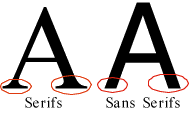 serif -
A short stroke or fine line
finishing off the main strokes
of a letter, whether hand drawn or of type,
as at the start and finish of the S's (as well as at the upper-left
of the lower-case h) in the title of this page. Such strokes are
characteristic of Roman letters. Common fonts
which have serifs are Bookman, Caslon, New York, Palatino, and
Times. Letters having no serif are called sans
serif. Also see capital letters,
lowercase, and typography.
serif -
A short stroke or fine line
finishing off the main strokes
of a letter, whether hand drawn or of type,
as at the start and finish of the S's (as well as at the upper-left
of the lower-case h) in the title of this page. Such strokes are
characteristic of Roman letters. Common fonts
which have serifs are Bookman, Caslon, New York, Palatino, and
Times. Letters having no serif are called sans
serif. Also see capital letters,
lowercase, and typography.
serigraphy - A stencil method of printmaking in which an image is imposed on a screen of silk or other fine mesh, with blank areas coated with an impermeable substance, and ink is forced through the mesh onto the printing surface. Also called silkscreen process and screen-printing. A serigraph is a print made by this method.
Examples:
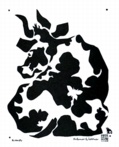
Schomer Lichtner (American, 1905-2006), Butterfly, 1975, serigraph. The shape of a white butterfly is in a negative space. Look between spots of black fur. Living in Wisconsin, Lichtner was renowned for paintings of ballerinas and dairy cows and his regionalist murals. See New Deal art.
Also see sericel.
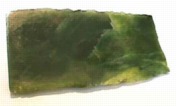 serpentine - A metamorphic
rock which takes a polish,
typically dark to yellowish green, sometimes brown, and often
with spots or mottling — its snake-like qualities. It is often considered
a marble. During the Renaissance green Greek porphyry was
described as antique serpentine. "Serpentine" can also refer to other reptilian attributes,
as in a curvatious or meandering form.
serpentine - A metamorphic
rock which takes a polish,
typically dark to yellowish green, sometimes brown, and often
with spots or mottling — its snake-like qualities. It is often considered
a marble. During the Renaissance green Greek porphyry was
described as antique serpentine. "Serpentine" can also refer to other reptilian attributes,
as in a curvatious or meandering form.
(SER-pən-teen)
An example:

Olmec culture (Mexico, Tabasco(?), Middle Preclassic period, about 900-300 BCE), Transformation Figure, serpentine with traces of cinnabar, height 4 1/4 inches (10.8 cm), Los Angeles County Museum of Art. This figure is apparently part man and part jaguar. See figure, Pre-Columbian, and Mesoamerican.
Also see Art Nouveau, maze, and Romanticism.
settecento - Italian, literally "seven hundred," it refers to the 1700s — the eighteenth century, and is often used to refer to Italian art of the time, the end of the Baroque and the beginning of the Neoclassical periods.
| Italian term | Numerically | English term |
|---|---|---|
| duecento | 1200s |
thirteenth century |
| trecento | 1300s |
fourteenth century |
| quattrocento | 1400s |
fifteenth century |
| cinquecento | 1500s |
sixteenth century |
| seicento | 1600s |
seventeenth century |
| settecento | 1700s |
eighteenth century |
| ottocento | 1800s |
nineteenth century |
| novecento | 1900s |
twentieth century |
| diecicento | 2000s |
twenty-first century |
setting - The hardening process of paint, plaster of Paris, concrete, resin, an adhesive, or any other material which must harden before working with it further.
Also see bleeding through and hot glue.
Seven Wonders of the Ancient World
severe style - An early, pre-Classical, transitional style of mid-fifth century BCE Greek statuary that is formal but not rigid in pose and emphasizes the principle of weight distribution; a liberation from the archaic limitation of frontal rigidity found in Egyptian portrait statues.
Also see balance, contrapposto, Egyptian art, Greek art, kore, and kouros.
sex - Male or female. The differences that distinguish the two genders are physiological, functional, and psychological. "Sex" can refer to the genitalia or to behaviors engaging genitalia, including procreation. Whether their intention is erotic, obscene, pornographic, or a means of exploring gender issues, art dealing with sexual content can be highly controversial (as works dealing with politics, religion, or criminality can also be), and may result in alienating viewers whose tastes are at variance from the artist's. Although behavioral standards have been changing over time — at various rates in various cultures — students, and others whose power is subject to more powerful authorities (whether respected or not), should understand potential consequences of making or exhibiting works with sexual content. This caution is not intended to justify the disapproval of those judging such works. Such issues are likely to be complicated, and must be studied on a case-by-case basis.
Example of work with sexual content:

Eric Gill (English, 1882-1940), Ecstasy, 1910-11, Hoptonwood stone
relief, 137.2
x 45.7 x 22.8 cm, Tate Gallery, London. When making this work,
Gill was strongly influenced by Indian temple sculptures, which
often show couples in the act of copulation. Gill's sculpture, like that found on Indian
temples, have a spiritual content.
He wrote that, "All creative acts have God for their author.
The human act of begetting is a type of divine creative power."
Gill titled a drawing for this work "Christ and the Church."
See Hindu art.
Also see beauty, erotica and erotic art, feminism and feminist art, fig leaf, First Amendment rights, gymnophobia, love, nude, obscenity, pornography, quotations, Romanticism, sensuality, sybaritic, and voyeurism.
sexpartite vault - A vault with six ribs and six panels.
Example:
![]()

![]()
France, a sexpartite vault at the
Abbey of Noirlac, 12th century.
sextodecimo - A book or manuscript of the next size smaller than an duodecimo. Sextodecimo is abbreviated 16mo, sometimes pronounced "sixteen-mo." The next smaller size is vicesimo-quarto.
Also see bookbinding, folio, quarto, signature, tricesimo-segundo.
SFA - Acronym for Section of Fine Arts. See the Section of Painting and Sculpture — part of the U.S. government's bureaucracy which administered New Deal art programs.
sfumage - See fumage.
sfumato - In painting, the technique of blurring or softening sharp outlines by subtle and gradual blending (feathering) of one tone into another. The smokelike haziness of this effect slightly lessens the perception that a still image is entirely still, instead lending a vague sense of movement. It is best known in the paintings of the Italian Renaissance artists Leonardo da Vinci (1452-1519) and Correggio (Antonio Allegri) (Italian, 1489-1534).
Examples of sfumato:

Leonardo da Vinci (Italian, 1452-1519), Madonna with a Flower (Benois Madonna),
begun 1478, oil on canvas,
19 1/2 x 12 1/2 inches (49.5 x 33 cm), Hermitage Museum, St.
Petersburg, Russia.

Leonardo da Vinci, Madonna Litta, c. 1490-91, tempera
on canvas, transferred from
panel, 16 1/2 x 13 inches (42 x 33
cm), Hermitage, St. Petersburg, Russia.
Leonardo da Vinci, Mona Lisa (La Joconde), c. 1503-1506, oil on wood panel, 77 x 53 cm, Louvre. This most famous of paintings is important for many reasons, not least of which is Leonardo use of sfumato. It seems to suggest that we are observing this face as its expression is changing. This portrait also presents early examples of aerial perspective and landscape painting. See Renaissance.
![]()
Correggio (Antonio Allegri) (Italian, 1489-1534),
Head of Christ, about 1530, oil
on wood panel,
11 1/4 x 9 1/16 inches (28.6 x 23 cm), J. Paul Getty Museum,
Malibu, CA.
Also see fumage and soft focus.
https://inform.quest/_art
Copyright © 1996-![]()